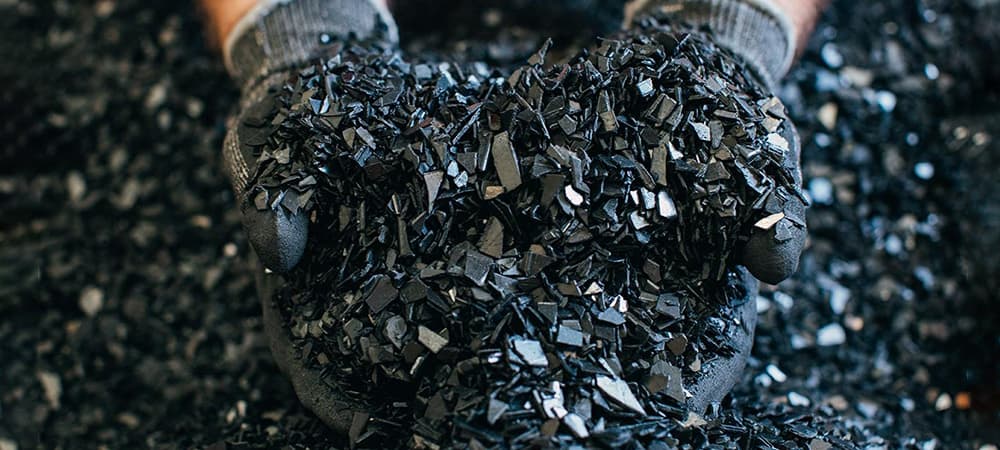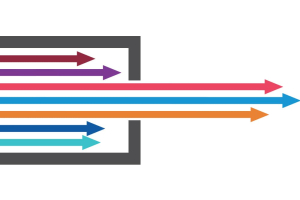We use cookies to offer you a better experience. For more information on how we use cookies you can read our Cookie and Privacy Policy.
Go Inside the Tennessee Facility Where Old Plastic is Turned into New Electronics
January 19, 2020

Amid humming machinery, beeping forklifts, and the steady work of employees in safety gear, spent HP ink cartridges enter their afterlife — a very productive one. On a typical day at HP’s recycling plant in La Vergne, Tennessee, about half an hour outside of Nashville, workers in orange vests and steel-toed shoes load cartridges onto conveyor belts. Others remove extraneous materials from the line of cartridges gliding by, ensuring they are disassembled in a way that maximizes the reuse of their components.
As the employees work, they are also helping to usher in a transformation in the printing industry — away from sending printers and cartridges to landfills, and instead integrating them into a circular economy that reuses materials again and again.
HP is on the cusp of the transformation, with an ambitious goal for all of its personal systems and print products to contain at least 30% recycled plastic by 2025. With its current portfolio at 7%, HP is taking steps to push the limits of technical innovation in recycling.
“The way we are going to get there is to figure out how we can recapture all the material we are putting out into the world and reuse every single bit of it,” says Ellen Jackowski, global head of sustainability strategy and innovation at HP. At HP’s recent Innovation for Sustainable Impact Summit in Nashville, Jackowski announced the release of the HP Tango Terra, which hits the 30% recycled target and uses cartridges that contain up to 73% recycled materials.
HP’s recycling effort also includes about 400 employees who work at the La Vergne facility’s two buildings, which are located across the street from each other and managed by Sims Recycling Solutions. One plant processes cartridges, and the other processes hardware, including printers and laptops. One of those employees, Tania Damaso, has worked at the recycling facility for about a year. She says that staff meetings always include information about recycling, and she likes that her job keeps plastic out of the environment.
“This is the Earth,” she says. “We have to take care of it.”
From old to new
The recycling chain for HP cartridges begins with customers, who have multiple options for sending their used cartridges into the circular system through the HP Planet Partners return and recycling program, which operates in 76 countries and territories around the world. People can use pre-addressed recycling envelopes. They can order free cardboard boxes from HP. Or they can drop cartridges off at stores, including Staples, Office Depot, Walmart, and Best Buy.
Customers who take the time to mail or drop off their used cartridges instead of throwing them away are essential players in HP’s recycling goals, says Shelley Zimmer, sustainable impact program manager at HP. “It demonstrates to me how much people care about the environment and about doing their individual part to make a difference,” she says.
Inside a cavernous warehouse at the La Vergne plant, thousands of cartridges fill large cardboard boxes, which line the floor and fill the shelves of 30-foot-tall steel racks. The cartridges have been sent in by customers in Canada, Latin America (cartridges from Brazil are recycled in Sao Paulo), and around the United States.
Damaso and her co-workers send the cartridges into a high-speed sorting line, where a conveyor belt carries different inkjet cartridge types beneath a high-definition camera, which funnels them into pathways with cartridges of the same type. The machine can distinguish up to 12 types of cartridges and sorts as many as 300 a minute, using artificial intelligence and machine learning to achieve about a 98% accuracy rate. As the cartridges move down the belt they are blown by air jets into a grid of boxes, separating them by type.
Some cartridges then go through the reverse engineering process that disassembles cartridges, component by component. Labels come off. Lids are removed and dropped into a bin for recovery. Foam is removed. Flexible circuits and the printhead are removed and the plastic is dropped into a bin to be combined with plastic from the recovered lids.
Other cartridges are shredded, rather than disassembled, by a giant shredding machine, whose blades break them into small pieces. A tank full of water begins the process of sorting the materials. Lighter plastics and foam float, while heavier plastics and metals sink. The disassembly process has improved the ability to recover more of the original cartridge plastic by 50%, compared with the standard methods shred and sort method, Zimmer says.
“If you were to smash a cartridge into tiny pieces and then try to pick the plastic or metal out from it, you can think about how inefficient that would be, rather than disassembling it,” she says. “You'll have more intact pieces in order to find good recycling solutions for all the materials.”
Across the street, used hardware from HP and other brands arrives by the truckload into receiving docks, where the items are weighed and registered. Then comes the manual deconstruction phase. With drills, screwdrivers, and other tools, employees take out batteries and parts that can’t go into the building’s own shredder. Materials are then separated with a sink-float mechanism, among other processes. Large, blue metal machines with nicknames — Heidi, Ginger, Otto, and Sally — do much of the work.
“The way we are going to get there is to figure out how we can recapture all the material we are putting out into the world and reuse every single bit of it.”
—Ellen Jackowski, global head of sustainability and innovation at HP
All of the plastic retrieved from the two locations is then shipped to a facility in Montreal run by the Lavergne Group. The recovered cartridge plastics are then combined with other recycled material such as bottles and hangers. The Canadian company reformulates the chemistry of the material, turns the plastic into pellets, and sends the raw material back to HP, which uses it to make new products that could eventually end up back at La Vergne.
HP estimates that in some cases, the same plastic moves through the Tennessee facility about a dozen times. “It can keep on going around the circle,” says Ingrid Sinclair, global president of Sims Recycling Solutions. “There is no end to it.”
It is an efficient system, but a scarcity of raw material and a lack of recycling infrastructure are major obstacles in the way of HP’s goal to increase the recycled content of products, Jackowski says. As HP and Sims work to increase supplies, they are also trying to increase awareness about the importance of recycling, an effort that includes the La Vergne facility. Shaun Burton, a machine operator at the facility who is also a graphic designer, has been fascinated to learn how ink cartridges are made and how the recycling process works. “I care about the Earth, and it only makes sense to try to take care of where we are,” he says. “Having a job that supports me and at the same time puts recycling at the center and helps the Earth — that’s a good feeling.”
Innovating to close the loop
To achieve its ambitious recycling goals, HP and Sims have turned to creative thinking and technological innovations. It’s fairly simple to melt cartridges and printers into lower-quality material that can be used to make flower pots, park benches, and other non-tech products. But HP has spent more than a decade developing an expanded recycling program, a disassembly strategy, and other innovations for turning used plastic into new high-quality plastic that can meet HP's demanding standards for printing products.
Developing the recipe for HP’s first recycled plastics took five years, Zimmer says. Based on that experience, HP was able to develop its second-generation recycled cartridges with just three years of work. The recipe for recycled printers like the HP Tango Terra came together in one year. The printer, which HP describes as “the world’s most sustainable home printing system,” is the company’s first to be certified as CarbonNeutral. It comes in plastic-free packaging, with instructions printed on the box instead of on extra paper. When customers purchase the HP Tango Terra, they also receive a pack of HP’s deforestation-free paper, certified by the Forest Stewardship Council.
“It’s a symbol of our commitment of a new HP vision to have forest-positive, carbon-neutral printing,” Jackowski says. “You really can do it. This product is the incarnation of that vision.”
Recycling advances have had real environmental impact, Zimmer adds. HP’s integration of recycled cartridges has reduced the carbon footprint of its plastics by 30%. Compared with virgin plastics, producing its recycled plastics uses 60% fewer fossil fuels and 39% less water.
In the last 28 years, HP has recycled more than 830 million cartridges and a total of 3.3 billion pounds of material — the equivalent in weight to 8,000 blue whales, Zimmer says. HP cartridges have also incorporated 4.4 billion plastic bottles and 101 million hangers. Teeth molds are another unexpected source of material. In a new pilot project, HP is collaborating with SmileDirectClub, a Nashville-based teledentistry company that provides teeth-straightening solutions. SmileDirectClub uses HP Jet Fusion 3D printers to manufacture tens of thousands of customized teeth molds each day from which clear aligners are made. Once aligners are made for customers, SmileDirectClub provides HP with the used plastic molds and excess 3D materials to recycle into pellets for traditional injection molding.
The spirit of recycling permeates all levels of action in the La Vergne facilities. Cartridges are stored and transported in reused packaging from the food industry, including cardboard boxes and enormous white bags labeled “peanuts only.” Metal extracted from print cartridges is resold on the metals market. And a machine originally designed to squeeze orange juice has been repurposed to squeeze residual ink out of cartridge foam recovered by the disassembly process. HP is exploring potential partners who might be able to use this recovered ink. From the shred and separate process, the sink/float water is sent to evaporators where residual ink is reduced to sludge for disposal, with the recovered water to be reused in the sink/float tanks.
Looking to the future, HP is pushing for new recycling innovations while also investigating the possibilities of turning more frequently to 3D printing as a way to increase efficiency by using only the materials needed, without any extra waste. The company will do what it takes, Jackowski says, to reduce the industry’s environmental impact.
“The world is shifting. The kids are on climate strike, telling all of us that they are demanding action,” Jackowski says. “We are listening.”






